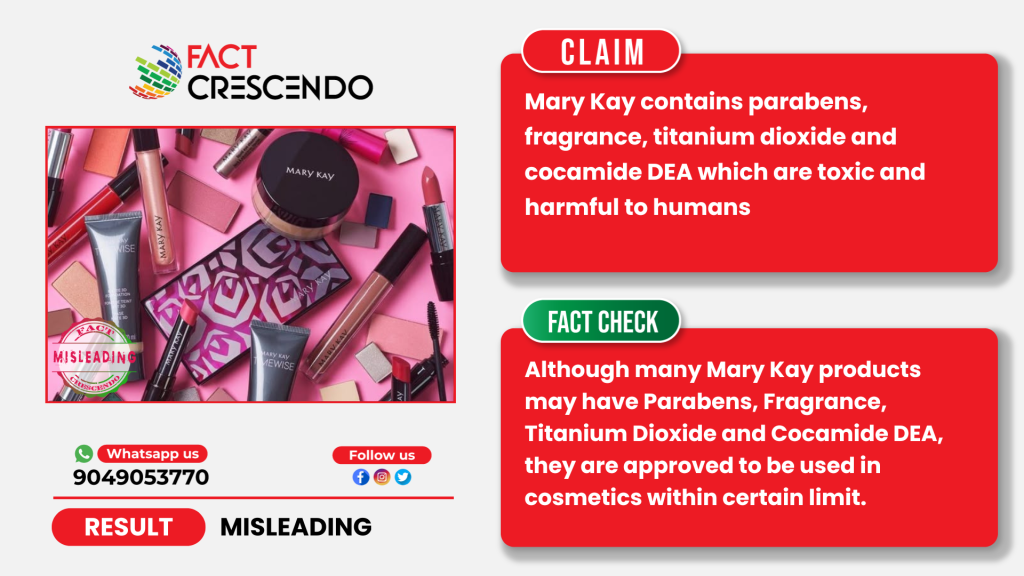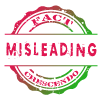
A social media post raises concern of the netizens by citing a few chemicals used in various Mary Kay products. Users are claiming that Mary Kay is using toxic chemicals in its products which have been proved to be harmful to humans. The list of chemicals mentioned in the post are Parabens, fragrance, titanium dioxide and cocamide DEA.
However, Fact Crescendo found the claim to be misleading. Parabens, fragrance, titanium dioxide and cocamide DEA are safe to use in cosmetics when used within restricted amount and concentration.
What’s the claim?
Social media users are claiming that Mry Kay, a well-known cosmetic brand uses parabens, fragrance, titanium dioxide and cocamide DEA in its products which are toxic in nature and leads to many critical health issues like breast cancer, migraine, endocrine disruption etc.
Fact Check-
As Mary Kay has many products, there may be some in which above mentioned ingredients could be found. You can read about the key ingredients of Mary Kay products here.
Paraben:
Parabens are preservatives used in cosmetics to stop harmful bacteria from growing. It may be a concern for people that Parabens in cosmetics may have the potential to act like estrogen which can be associated with the development of breast cancer. However, parabens have significantly less estrogenic activity than the body’s naturally occurring estrogen. Parabens in cosmetics are present only in very small amount and are not harmful to humans at this level.
Studies and reviews have shown that parabens have low toxicity and do not cause cancer when used within the safety limits established by regulatory authorities. However, concerns remain about their potential hormone-like activity, particularly in young children. While current regulations consider parabens safe for use, ongoing research aims to address uncertainties and ensure their safe use.
Fragrance:
According to a report, Fragrances in cosmetic products are regulated under the Federal Food, Drug, and Cosmetic Act (FD&C Act), granting the FDA authority to ensure safety. But, products like laundry detergents and air fresheners with fragrances are overseen by the Consumer Product Safety Commission (CPSC). While most cosmetic ingredients must be individually listed, fragrances are treated as a trade secret and are labelled as “fragrance” on the product. In the European Union (EU), fragrances are labelled as “parfum,” but if certain allergens are present in specified amounts, they must be listed separately. These regulations allow manufacturers to protect the confidentiality of fragrance compositions while ensuring consumer safety.
Fragrances in cosmetics are regulated by the FDA, while those in household items like detergents are overseen by the Consumer Product Safety Commission. The Modernization of Cosmetics Regulation Act (MoCRA) law requires listing fragrance allergens on cosmetic labels, but specific ingredients are often labelled as “Fragrance” or “Flavour” to protect trade secrets. The International Fragrance Association (IFRA) sets safety standards with forbidden and restricted ingredient lists. Although fragrances aren’t FDA-approved, companies must ensure they are safe, and new laws aim to enhance consumer protection.
Titanium Dioxide:
Titanium Dioxide (TiO2) in its nanoparticle form (nano-TiO2), is commonly used in products like sunscreens, day creams, foundations, and lip balms due to its ability to block UV rays and prevent skin damage. While it is effective at preventing sunburn and skin cancer, there are concerns about its safety due to its small size, which might allow it to enter the body through the skin, lungs, or digestive system. However, most studies show that nano-TiO2 does not penetrate deeper than the outer layers of the skin and does not reach the bloodstream. The European Scientific Committee on Consumer Safety (SCCS) has concluded that nano-TiO2 is safe when applied to the skin at concentrations up to 25%, and there is no evidence it causes cancer, genetic mutations, or reproductive harm. However, the SCCS advises against using nano-TiO2 in products that could be inhaled, like sprays or powders, as it could cause lung inflammation in animals. Oral exposure, like from lip balms, is also considered safe with no significant health risks.
According to a website, the U.S. Food and Drug Administration (FDA) has checked the safety of titanium dioxide for use in foods, drugs, cosmetics, and sunscreens. The FDA has also provided guidance on how to use titanium dioxide safely as a food colouring. It has confirmed that titanium dioxide is safe to use in cosmetics, including those applied around the eyes.
Based on studies on rats, it was found that upon inhalation of Titanium dioxide lung tumour growth was noticed. However, extensive studies on titanium dioxide industry workers do not suggest an association between occupational exposure to titanium dioxide and an increased risk for cancer in humans.
Cocamide DEA
According to FDA, National Toxicology Program (NTP) studied the effect of Cocamide and other DEA and found it to be carcinogenic in laboratory animals. But, the NTP study did not establish a link between DEA and the risk of cancer in humans. However, based on information filed with FDA’s Voluntary Cosmetic Registration Program, it was found that DEA-related ingredients are used much less frequently in cosmetic products than they were when the NTP completed its study.
FDA also stated that there is no reason for consumers to be alarmed for the use of DEA substances in cosmetics. It also labelled Cocamide DEA as one of the most commonly used ingredients. FDA is still monitoring the health hazard of the substance.
According to National Library of Medicine, The Cosmetic Ingredient Review (CIR) Expert Panel studied the diethanolamides chemicals, including how they break down in the skin to form DEA and fatty acids. The panel concluded that these ingredients are safe to use if they are formulated in a way that doesn’t irritate the skin and if the amount of free DEA stays within safe limits. However, the panel advised against using these ingredients in products where harmful N-nitroso compounds could form.
Conclusion:
Fact Crescendo found the claim to be misleading. Although many Mary Kay products may have Parabens, Fragrance, Titanium Dioxide and Cocamide DEA, they are approved to be used in cosmetics within certain limit.

Title:Don’t be alarmed! Mary Kay cosmetics uses approved ingredients in its cosmetics products.
Fact Check By: Siddharth SahuResult: Misleading


